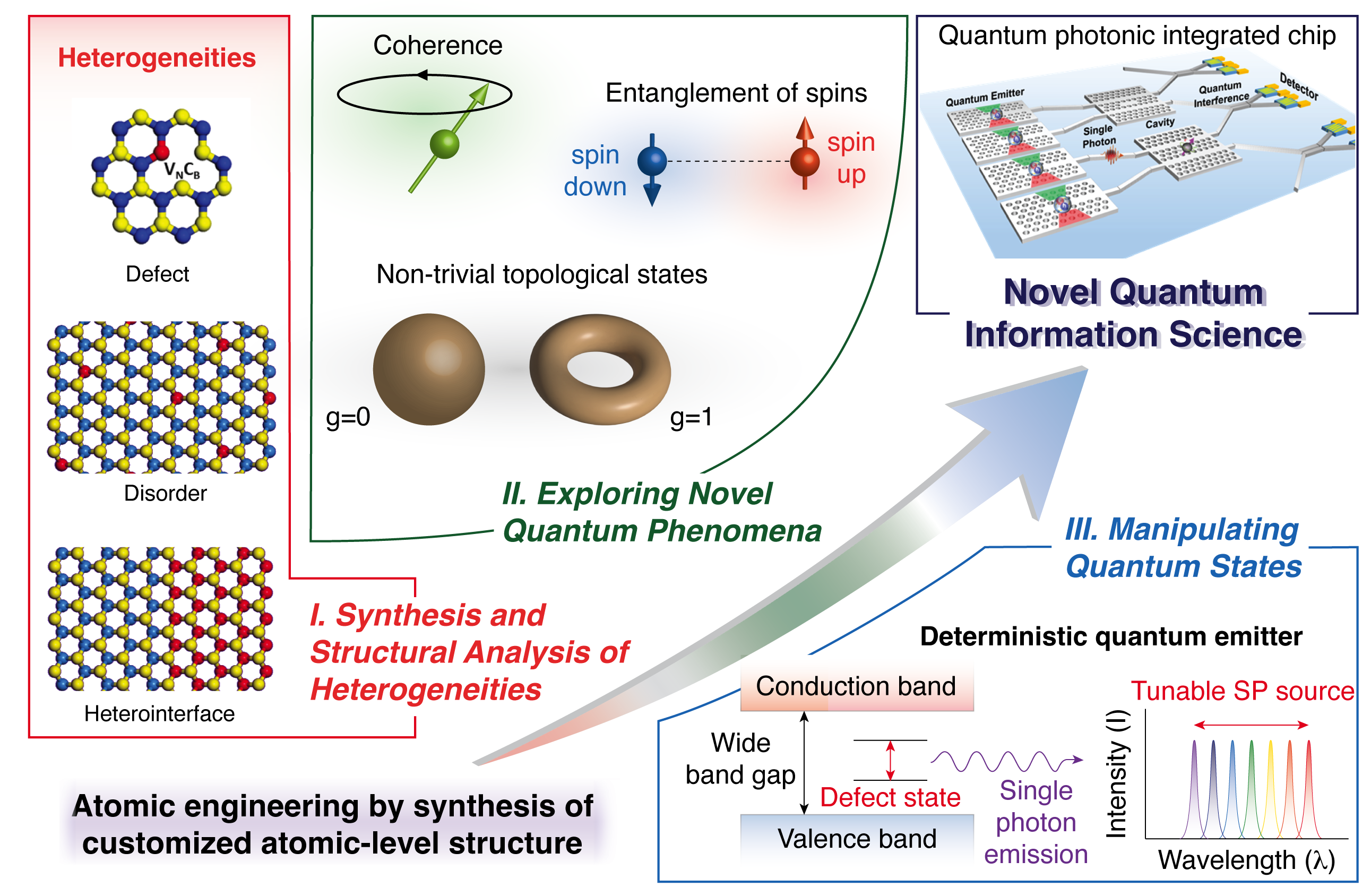Research
Research
Research program
The IBS Center for 2D Quantum Heterostructures stands at the forefront of exploring the extraordinary quantum phenomena that emerge in a new class of materials - 2D heterostructures. These materials are meticulously crafted by combining single- or few-atomic-layer-thick 2D materials, which allows us to engineer their properties at the atomic level, resulting in a fascinating interplay between their electronic structures. Due to inherent quantum confinement, quantized electronic states arise within these materials, giving rise to a spectrum of exotic quantum phenomena.
The field of 2D heterostructures is growing rapidly with significant potential for fundamental science and applications. Scientists are actively exploring diverse avenues, including the manipulation of moiré patterns, bandgap engineering, exciton physics, unconventional superconductivity in van der Waals heterostructures, and the integration of 2D magnetic materials. However, a significant challenge exist in the field: creating various high-quality 2D/1D/OD heterostructures in large areas is quite challenging. In particular, the customized synthesis of in-plane heterostructures to investigate the atomic-level structure-property relationship is in its infancy. Overcoming this challenge is paramount to unlocking a new paradigm in condensed matter physics, paving the way for a future filled with technological breakthroughs.

To understand the fascinating world of 2D quantum heterostructures, the center will develop platforms for studying their physics and chemistry. These platforms will utilize three key materials: BCxN, TMDs, and hBN, allowing researchers to explore the potential of these materials for groundbreaking discoveries.
(1) Ternary BCxN heterostructures
Various ternary BCN (or BCxN) structures comprise B, C, and N. However, the phase- and composition-controlled synthesis of BCN structures remains challenging. The BCN structures reported in most literature have random compositions of B, C, and N, which are referred to as BxCyNz, or exist as BNC structures as a mixture of hexagonal boron nitride (hBN) and graphene domains. The center will attempt to synthesize various BCxN structures from on-demand precursors, which can be 2D quantum heterostructures. For instance, a single hexagonal hBN can be periodically embedded in a graphene monolayer to form an array. To realize such BCxN structures, we will first design and synthesize precursors for target BCxN structures and grow them in large areas by dehydrogenation and self-assembly on metal surfaces. Finally, the composition-dependent electronic structure and physical properties of the BCxN structures will be investigated.
(2) Transition metal dichalcogenide (TMDs) heterostructures
We will study physics and chemistry of TMDs, including 2D topological materials and ternary crystals such as transition metal phosphorous chalcogenides, and their heterostructures. Currently, 2D TMDs are actively studied because dimensionality reduction, from bulk 3D to 2D, leads to new physical phenomena and topological phase transitions. First, the center will start high-quality synthesis of 2D TMDs by chemical vapor deposition and colloidal synthesis and ultimately pursue further reduction in dimensionality to 1D and OD TMDs and their in-plane heterostructures such as 1D/2D and 0D/2D, leading to changes in the electronic band structures and resulting unprecedented quantum phenomena. If such in-plane heterostructures are fabricated, they will be vertically stacked to predict the correlation and interaction between the electrons, photons, and spins.
(3) hBN for single-photon emission
hBN is a promising candidate for quantum emitters at room temperature. However, the origin of the defects in hBN that cause single-photon emission remains debatable. The center will grow high-quality single-crystal hBN on the wafer scale and attempt to artificially create defects in hBN or develop a method for realizing spatially controlled carbon-doped hBN (carbon doping in a spatially patterned hBN region). These structures will be platforms for studying single-photon emission and ultimately fabricating quantum integrated devices. In addition to the aforementioned fundamental research in materials synthesis and physics, the center will explore various applications such as quantum technology, semiconductor technology, and energy conversion and storage.

 Center for 2D Quantum Heterostructures (2DQH)
Center for 2D Quantum Heterostructures (2DQH)